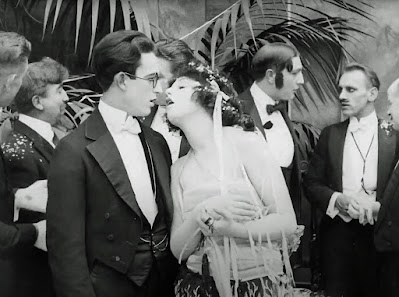Starring: Douglas Fairbanks, Bessie Love, Sam de Grasse, and Pomeroy Cannon
Director: Allan Dwan
Rating: Eight of Ten Stars
"Passin' Through" (Fairbanks), a wandering outlaw with a heart of gold and a soft spot for those who are defenseless and in need, finds himself falling head-over-heels in love with a young woman (Love) he encounters by chance. This is sets in motion a series of events that will reveal "Passin'" mysterious past and change both their lives forever.
As I've mentioned before, I generally don't have the patience for silent dramas, especially if they run past the 15-20 minute mark. "The Good Bad-Man" is one of a growing number of films I've come across that are an exception to that rule. I don't know if my tastes have changed or if I've just had more luck with picking movies to watch in recent years.
Whatever the reason, I found "The Good Bad-Man" to be very entertaining. It's easy to see why Douglas Fairbanks was such a big star in his day, as he is seems equally natural whether his character is being friendly and playful, or whether he's getting ready to kill someone.
In fact, like the other early Fairbanks picture I've watched and reviewed (the subversive Sherlock Holmes parody "The Mystery of the Leaping Fish"), he is the star of the film in very sense: He's the main character, he has all or is a key part of all the film's best moments, and he has a presence that almost leaps off the screen in every scene. Like their previous pairing, Fairbanks and Love also make a great couple on screen, with acting styles and on-screen chemistry that make them seem like a natural couple. Even the "insta-romance" between the characters doesn't bother me that much here, because Fairbanks and Love compliment each other so well.
Speaking of Love, I noticed that she spends most of her scenes either sitting down or leaning against posts or walls after taking just a few steps. I don't know if this is just some weird coincidence or if it was supposed to be a character quirk, but I also found myself wondering if perhaps Love perhaps had hurt one of her legs or perhaps her back. What little research I felt inclined to do didn't reveal anything specific, so if it was anything, it was probably just a sprained ankle.
Another bit I noticed--that is either a coincidence or an intentional sight gag--was a rider having trouble with his horse both times the band of outlaws saddled up and rode out en-masse. I'm hoping it was an intentional ittle background thing. Perhaps there was even something involving a clumsy comic relief character that ended up getting cut when the film was reportedly shortened for its 1923 release... I wish my imagining is true, because a cowboy outlaw who can't stay on a horse would be hilarious. (Unforunately, we will never know, because there are no known surviving copies of the original 1916 cut.)
Aside from excellent performances from the film's stars, Sam de Grasse has a fine turn as a local bandit leader whose secret connection to "Passin' Through" helps turn the plot upside down and accelerate the film toward its dramatic conclusion. Similarly Pomeroy Cannon, who plays a Federal Marshal who remains a question mark for most of the picture as to whether he was going to be a friend to the main characters or their downfall, also gives a fine supporting performance.
"The Good Bad-Man" is one of the films that have been featured in the Screening Room at the YouTube channel that's loosely connected with this blog. If you like westerns and fast-paced silent movies, you're probably going to enjoy this one. Just click below and watch the tale unfold!







































.jpg)







.jpg)
